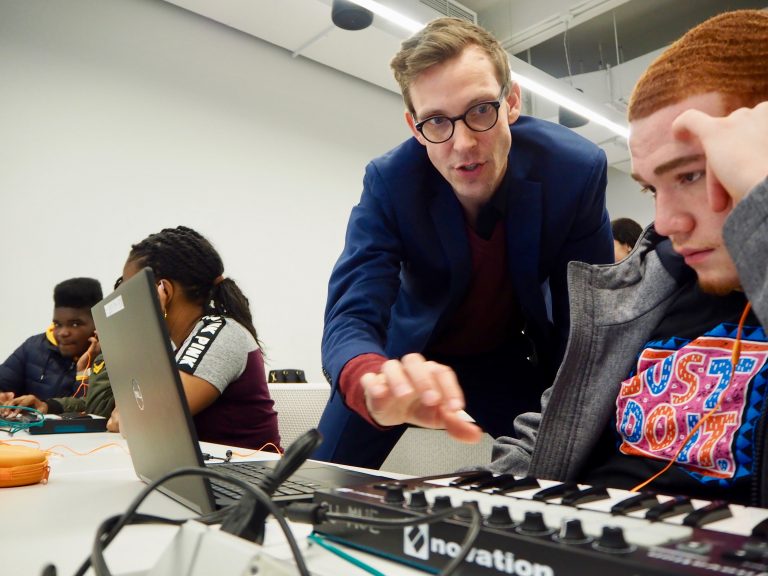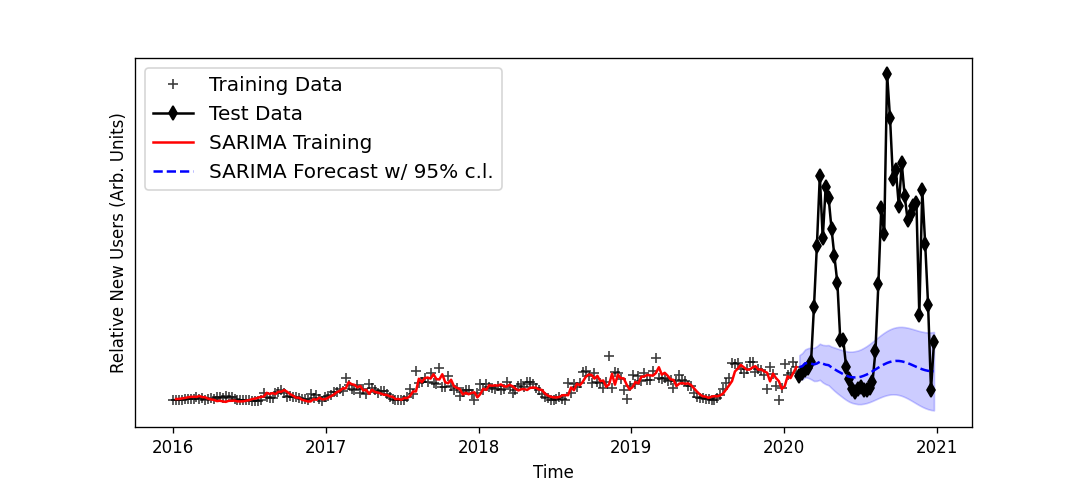Digital Music

David H. Knapp works with a student from the Leadership and Public Service High School in New York City.
Digital music offers the field of Music Education novel opportunities for inclusion by providing music-making activities that are responsive to many students' extant musical practices, including those that have been historically marginalized from participating in music education. Leveraging students' native interest in digital media, creative platforms like Ableton Live and Soundtrap can be used to facilitate high-level creativity, while also pursuing learning outcomes relating to critical literacy.
I have developed two programs that use digital music to bridge the gap between the university and the populations it aims to serve. On Campus, I received a CUSE Grant ($30,000) to co-create the SENSES Lab, a music and podcast production lab intended to give voice to first generation and socio-economically marginalized college students participating in the university's HEOP and SSS opportunity programs. Off campus, I developed the Digital Music Lab at MercyWorks, a non-profit for economically-marginalized high school students to develop vocational and life skills. The lab also provides an opportunity for undergraduate and graduate students to gain field experiences in a diverse setting.
The Digital Music Lab extends MercyWorks' skills-based focus by having students engage in creative and critical activities as they musically encode their experiences through DAWs. This is done by facilitating mediated interactions for students with audio and visual media, like YouTube, and production software, like Ableton and Soundtrap. During the 15-week lab course, students begin with critical listening activities. They are then invited to develop their own sound through scaffolded interactions with the DAW. Finally, students are asked to think deeply about their own experiences, and are guided to encode these experiences musically through the DAW. The structure of this lab was developed through a collaborative workshop I facilitated in New York City in 2019 among leaders in Hip-Hop pedagogy, entitled Hip-Hop and American Life.
In addition to developing community-based digital music programs, I also find a lot of joy in making digital music! If given a free moment in my office, I am quick to open up Ableton Live or Native Instruments' Traktor to musically explore and make for myself the same musical opportunities I like to make for my students. In 2020, at the beginning of the pandemic, colleagues of mine at other institutions met each week for Soundtrap Happy Hours. The premise was simple, we had exactly one hour to make a pop tune in response to a prompt (e.g. Breakup Song, #BLM). Once the hour was up, we could no longer add any more music, and could only master the track with limited mixing. After a year of this, we released our favorite tracks as an EP on Bandcamp and on limited vinyl under the name Larry and the Happy Hours. Our band also used this opportunity to theorize how these amateur musical practices might be brought further into the classroom.
My latest research on digital music-making examines contemporary music education practices by utilizing big data to ask new questions of the field, and ask old questions in new ways. Through a recent partnership with Soundtrap (a subsidiary of Spotify), I have been able to examine large datasets using machine learning methods to better understand how digital tools are being used to promote musical creativity in music education. This new research endeavor has led to two recent article submissions, one about Soundtrap's usage in the United States during the pandemic
As this partnership with Soundtrap develops, I have assembled an international and interdisciplinary research team of music educators, physicists, librarians, data scientists, musicologists, and composers, to design new research methodologies to further interrogate our rich data set. We currently have an application under review for the NEH's Digital Humanities Advancement Grant ($150,000) to map Soundtrap's user-selected loops in dimensional space according to their metatags (e.g. Reggae, Dark, Riff). We hope this project will not only narrowly answer questions relating to creative taxonomies that exist in digital music-making, but also allow for the development of cutting-edge research infrastructure in music education that can translate these large data sets into knowledge about our field.
Knapp, D. H., Powell, B., Smith, D. G., Coggiola, J., & Kelsey, M. (2023.). Soundtrap during COVID-19: A machine-learning approach to assess the effects of the pandemic on music education. Research Studies in Music Education. https://doi.org/10.1177/1321103X221149374
Knapp, D. H., Caruso, M., Kelsey, M., Powell, B., Smith, D. G., & Coggiola, J. (Under review.). Global disparities in online music learning during COVID-19: A machine-learning approach based on data from the web-based DAW Soundtrap. International Journal of Music Education.
Gramm, W., Powell, B., Smith, D. G., & Knapp, D. H. (Under review.). Popular music education as community music practice: Music educators’ experiences of teaching modern band remotely during the COVID-19 pandemic. Research Studies in Music Education.
 Daily new educational users for Soundtrap in the United States. The (gray) plus points show the pre-COVID data used to train the SARIMA model, and the (black) diamond points show the COVID test data. The (red) solid line shows the SARIMA model performance after training and the (blue) dashed line shows the SARIMA forecast. The blue band shows the 95% c.l. on the forecast model.
Daily new educational users for Soundtrap in the United States. The (gray) plus points show the pre-COVID data used to train the SARIMA model, and the (black) diamond points show the COVID test data. The (red) solid line shows the SARIMA model performance after training and the (blue) dashed line shows the SARIMA forecast. The blue band shows the 95% c.l. on the forecast model.